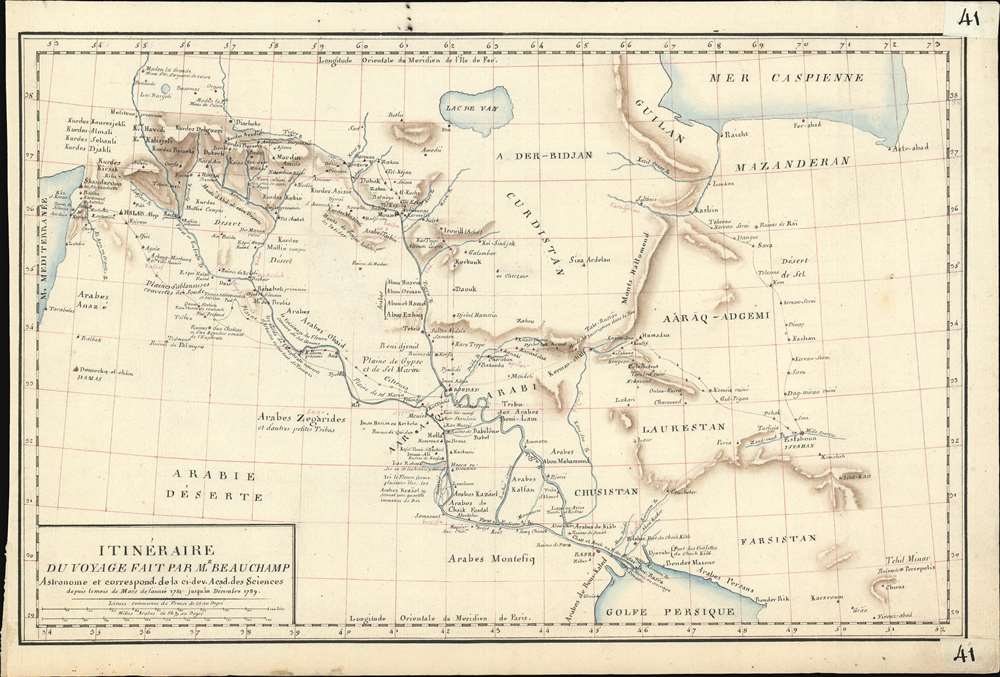This item has been sold, but you can get on the Waitlist to be notified if another example becomes available, or purchase a digital scan.
1790 Beauchamp Manuscript Map of Persia / Iran, Iraq, and Syria
SyriaPersia-beauchamp-1790
Title
1790 (dated) 11.5 x 17.25 in (29.21 x 43.815 cm) 1 : 4464000
Description
Beauchamp's Journeys
Beauchamp was initially summoned to Bagdad as part of the ecclesiastical duties associated with his uncle, Jean-Baptiste Miroudot du Bourg, titular bishop of Baghdad. Beauchamp and his uncle arrived in Aleppo in September of 1781. While Miroudot du Bourg remained in Aleppo, possibly for health reasons, Beauchamp continued to Bagdad. He carried with him an assortment of marine and astronomical instruments, procured for him by the aforementioned de Lalande. He used these extensively, making astronomical observations along the route, as well as notes on the people, ruins, topography and culture he encountered. This route is marked in detail along with his nightly stops.In January of 1784, Beauchamp made another major journey, this time from Bagdad to Basra, on the Persian Gulf, visiting the ruins of Babylon en route. He is known to have constructed a detailed map of the vicinity of Babylon, also for de Lalande, but this has been lost. Here too, his observations were revolutionary
In 1787 De Lalande requested Beauchamp make a journey to the Caspian Sea to fix its southern coodinates. The journey, which took him through Isfahan, was apparently a difficult one, wherein Beauchamp met with unfriendly locals and contracted malaria. He made it as far as Qazvin (Kasbin, Iran), about 60 miles south of the Caspian Sea, where he convalesced. Beauchamp was nonetheless able to continue with astronomical measurements, recording a June 30, 1787 eclipse of the moon that de Leland called 'one of the most important ever observed.' Due to his illness, Beauchamp did not return ot Bagdad until January 1788.
The final record on this map is Beauchamp's return Journey. He left Bagdad on December 1, 1789, arriving in Paris on September 3, 1790. Some of his research and observations were recorded in the Journal des Savants, the world's oldest scientific journal.
De Lalande's Map?
This map was apparently never printed and published, surviving on here in manuscript. The only reference we found of this work is in a biographical account of Joseph de Beauchamp composed by de Lalande, in which he writes…a chart of the course of the Tigris and the Euphrates from Diarbeker [Diyarbakır] to the Persian Gulph, that is to say, for an extent of 300 leagues, which he constructed on that occasion, is in my possessions…It is highly likely this is that very map, or at least a contemporaneous copy thereof. While we do not have an iron-clad provenance, we do know that it was bound into a partial but meticulously compiled composite atlas with a heavy focus on Asia and the Middle East - the kind of thing de Lalande might have owned.
The 'JK ool' Watermark
The paper is watermarked 'JK ool' (Churchill 129). 'JK ool' watermarks commonly appear on French paper issued between 1701 to 1800. Most examples of 'JK ool' paper feature a fleur-de-lis over the 'JK ool' text, but as this paper was likely produced after 1789, it is not surprising that the papermaker may have removed the fleur-de-lis in an effort to distance itself from this icon of French royal authority. In the current instance, it helps significantly to date the piece as no 'JK ool' watermarked paper is known to have been produced after 1800.Publication History and Census
This map was drawn based upon the travels of Pierre-Joseph de Beauchamp, possibly in his own hand. It is the only known example. Underscoring its obscurity, Beauchamp's work does not appear in Cyrus Alai's definitive General Maps of Persia. An extraordinary collecting opportunity.Cartographer
Pierre-Joseph de Beauchamp (June 28, 1752 - November 18, 1801) was a French diplomat, clergyman, and astronomer active in the middle east in the late 18th century. Born in Nice, Beauchamp was the son of the lawyer Xavier de Beauchamp. In 1781 he was appointed vicar general to his uncle, Miroudot du Bourg, titular bishop of Baghdad. He and his uncle left France for Aleppo and from thence, Bagdad, arriving later in that year. In the subsequent year, he, along with French consul Jean-François Rousseau and the botanist André Michaux traveled extensively throughout modern day Iran and Syria, taking astronomical readings along the route. He returned to France in 1780. Five years later, on March 3, 1795, he was appointed consul at Muscat, in Oman. In 1799, Napoleon Bonaparte sent him on a peace embassy to the Ottoman Sultan Selim III (1761 - 1808). His ship, unfortunately, was captured by the English Royal Navy. The Royal Navy consigned Beauchamp's keeping to the Ottomans, who now at war with France, imprisoned him at the notorious Yedikule Fortress. Life in prison left Beauchamp physically and mentally broken. He was freed and returned to France during the Peace of Amiens (1801 - 1802), but died shortly thereafter. More by this mapmaker...

